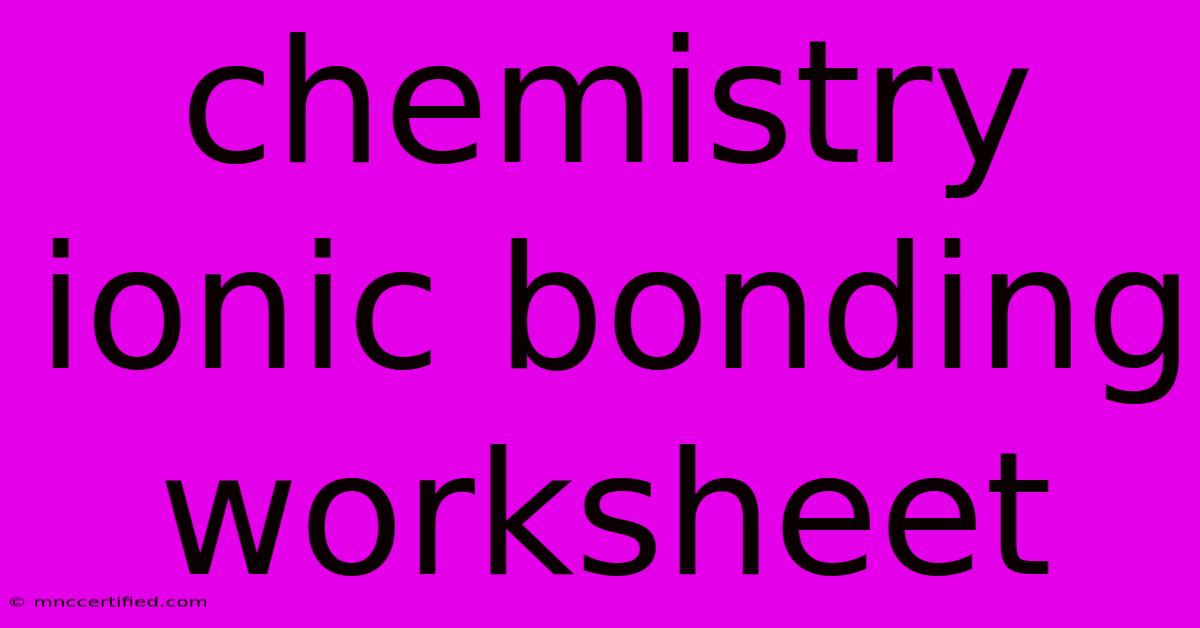Chemistry Ionic Bonding Worksheet

Table of Contents
Mastering Ionic Bonding: A Comprehensive Worksheet Guide
Are you struggling with ionic bonding? This comprehensive guide provides a detailed explanation of ionic bonding, along with a sample worksheet and answers to help you master this crucial chemistry concept. We'll cover everything from the fundamentals to advanced applications, ensuring you have a solid understanding to ace your next chemistry test or assignment.
What is Ionic Bonding?
Ionic bonding is a type of chemical bond formed through the electrostatic attraction between oppositely charged ions. This occurs when one atom donates electrons to another atom, resulting in a cation (positively charged ion) and an anion (negatively charged ion). The strong electrostatic forces between these ions hold the compound together.
Key Characteristics of Ionic Bonds:
- Electron Transfer: The defining characteristic is the transfer of electrons, not sharing like in covalent bonds.
- Electrostatic Attraction: The bond is formed due to the attraction between positive and negative charges.
- High Melting and Boiling Points: Ionic compounds generally have high melting and boiling points because of the strong electrostatic forces.
- Crystalline Structure: Ionic compounds usually form a crystalline structure, a regular, repeating arrangement of ions.
- Conductivity: Ionic compounds conduct electricity when molten (melted) or dissolved in water because the ions are free to move.
- Brittle Nature: Ionic crystals are often brittle because the shift of ions can cause repulsion between like charges, leading to fracture.
Understanding the Process: A Step-by-Step Guide
Let's break down the ionic bonding process with a simple example: the formation of sodium chloride (NaCl), common table salt.
-
Sodium (Na) loses one electron: Sodium, an alkali metal, readily loses its single valence electron to achieve a stable electron configuration (like neon). This creates a sodium cation (Na⁺).
-
Chlorine (Cl) gains one electron: Chlorine, a halogen, readily gains one electron to achieve a stable electron configuration (like argon). This creates a chloride anion (Cl⁻).
-
Electrostatic Attraction: The positively charged sodium ion (Na⁺) and the negatively charged chloride ion (Cl⁻) are attracted to each other due to their opposite charges, forming an ionic bond.
-
Crystal Lattice Formation: Millions of Na⁺ and Cl⁻ ions arrange themselves in a regular, repeating three-dimensional structure called a crystal lattice, maximizing electrostatic attractions and minimizing repulsions.
Ionic Bonding Worksheet: Practice Problems
Here's a sample worksheet to test your understanding. Remember to show your work!
Part 1: Identify the ions formed:
- Magnesium (Mg)
- Oxygen (O)
- Aluminum (Al)
- Sulfur (S)
Part 2: Predict the formula of the ionic compound formed between:
- Sodium (Na) and Chlorine (Cl)
- Calcium (Ca) and Oxygen (O)
- Aluminum (Al) and Sulfur (S)
- Magnesium (Mg) and Nitrogen (N)
Part 3: Explain why ionic compounds have high melting points.
Part 4: Draw a simple diagram showing the arrangement of ions in a sodium chloride crystal lattice. (Hint: focus on illustrating the alternating positive and negative charges)
Ionic Bonding Worksheet: Answers
Part 1:
- Mg²⁺
- O²⁻
- Al³⁺
- S²⁻
Part 2:
- NaCl
- CaO
- Al₂S₃
- Mg₃N₂
Part 3: Ionic compounds have high melting points because of the strong electrostatic forces of attraction between the oppositely charged ions in the crystal lattice. A significant amount of energy is required to overcome these strong forces to melt the compound.
Part 4: Your diagram should show a repeating pattern of Na⁺ and Cl⁻ ions, alternating in a cubic arrangement.
Further Exploration and Resources
To deepen your understanding of ionic bonding, explore online resources like Khan Academy, Chemistry LibreTexts, and your textbook. Practice more problems and explore different ionic compounds to solidify your knowledge. Remember to consult your teacher or professor if you have any questions. Mastering ionic bonding is a crucial step towards success in chemistry!

Thank you for visiting our website wich cover about Chemistry Ionic Bonding Worksheet. We hope the information provided has been useful to you. Feel free to contact us if you have any questions or need further assistance. See you next time and dont miss to bookmark.
Featured Posts
-
Ravens Week 11 Roster Steelers Matchup
Nov 18, 2024
-
Barry Bonds Signed Baseball Worth
Nov 18, 2024
-
Snow And Ice Uk Cold Weather Warnings
Nov 18, 2024
-
How To Watch Chiefs Bills Game Live
Nov 18, 2024
-
Festival Fury Glastonbury Ticket System
Nov 18, 2024